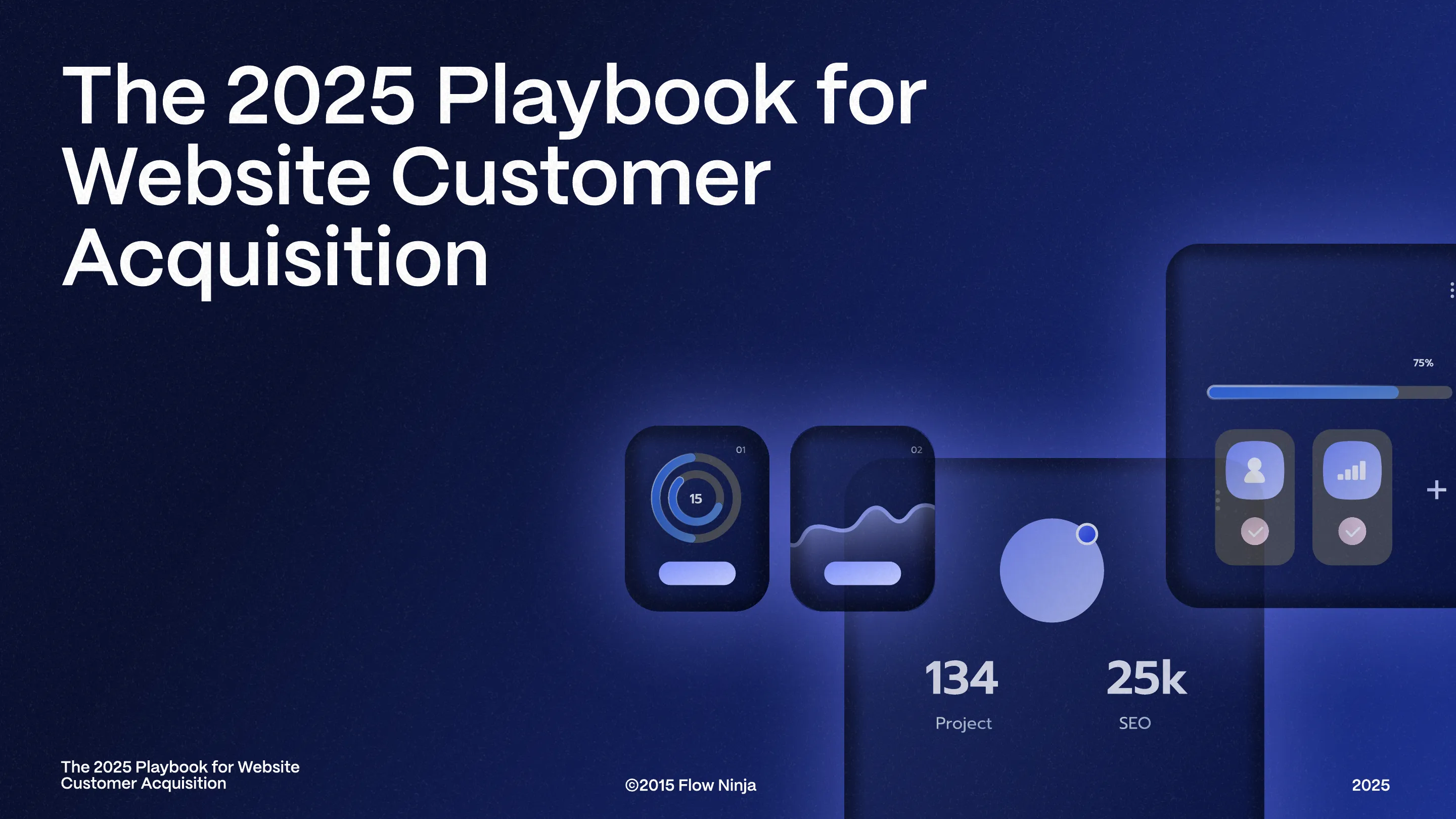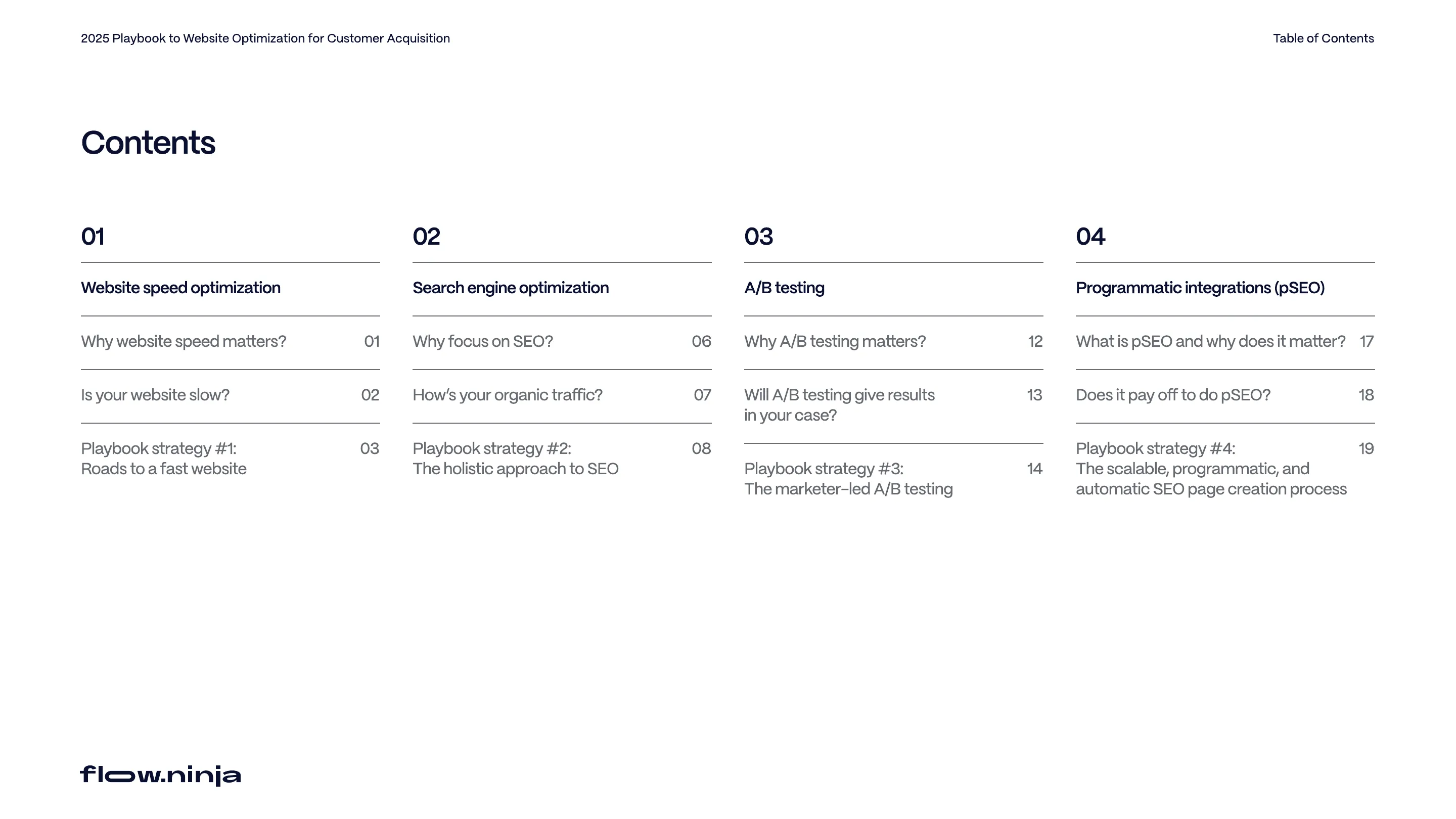The 2025 Playbook for Website Customer Acquisition
Slides about The 2025 Playbook for Website Customer Acquisition. The Pdf, a presentation for university students in Economics, outlines key strategies for digital marketing, including website speed optimization, SEO, A/B testing, and programmatic integrations.
Mostra di più51 pagine


Visualizza gratis il Pdf completo
Registrati per accedere all’intero documento e trasformarlo con l’AI.
Anteprima
The 2025 Playbook for Website Customer Acquisition
The 2025 Playbook for Website Customer Acquisition
@2015 Flow Ninja
2025 Playbook to Website Optimization for Customer Acquisition
Table of Contents
Contents
01 Website speed optimization
02 Search engine optimization
03 A/B testing
04 Programmatic integrations (pSEO)
Website speed optimization
Why website speed matters?
01 Why website speed matters?
02 Is your website slow?
03 Roads to a fast website
Search engine optimization
Why focus on SEO?
06 Why focus on SEO?
07 How's your organic traffic?
08 The holistic approach to SEO
A/B testing
Why A/B testing matters?
12 Why A/B testing matters?
13 Will A/B testing give results in your case?
14 The marketer-led A/B testing
Programmatic integrations (pSEO)
What is pSEO and why does it matter?
17 What is pSEO and why does it matter?
18 Does it pay off to do pSEO?
19 The scalable, programmatic, and automatic SEO page creation process
flow.ninja
2025 Playbook to Website Optimization for Customer Acquisition
Table of Contents
Contents
05 Strategic social proof and testimonials
06 Use of cookies and remarketing
07 Utilizing lead magnets throughout the website
08 Tracking and optimizing further
Strategic social proof and testimonials
How can social proof actually help?
22 How can social proof actually help?
23 Should you add social proof and will it have impact
24 How to let others toot your horn
Use of cookies and remarketing
Is remarketing really necessary?
25 Is remarketing really necessary?
27 Should you remarket your website visitors
28 Make hay while the sun shines
Utilizing lead magnets throughout the website
What's the actual power of lead magnets?
30 What's the actual power of lead magnets?
31 Who has the problem?
32 Understanding the magnetic flux density
Tracking and optimizing further
Why is it a problem?
34 Why is it a problem?
35 Who has the problem?
36 Always Be Tracking
Conclusion
38 Make your website marketing matter
Ready to take your website marketing to the next level?
flow.ninja
2025 Playbook to Website Optimization for Customer Acquisition
Website speed optimization
Website speed is one of the primary factors affecting the website's overall performance in customer acquisition.01
2025 Playbook to Website Optimization for Customer Acquisition
Why website speed matters?
A slow website negatively impacts this by increasing the blended and paid acquisition costs. Poor performance leads to higher bounce rates, lower conversion rates, and reduced ad quality scores, driving up the costs of acquiring customers through both organic and paid channels.
In 2018, Google conducted a test on 11 million websites, claiming the average speed of loading for mobile websites is 15.3 (Google Research, Webpagetest.org, 2018.) In an ideal scenario, the site should take 1- 2 seconds to load. It follows that by achieving great website speed, you're already gaining a competitive advantage.
G The probability of bounce increases 32% as page load time goes from 1 second to 3 seconds.
Google/SOASTA Research, 2017.
flow.ninja02
2025 Playbook to Website Optimization for Customer Acquisition
Is your website slow?
To diagnose and address this issue, you can use tools like Google Lighthouse and PageSpeed Insights.
Google Lighthouse
A browser widget that provides an in-depth audit of your website's performance, accessibility, best practices, SEO, and more. It helps you identify areas for improvement to enhance your site's overall speed and user experience.
PageSpeed Insights
Another Google tool that analyzes a web page's content and generates suggestions for making it faster. It provides a score based on your site's performance on mobile and desktop devices, along with actionable recommendations.
flow.ninja03
2025 Playbook to Website Optimization for Customer Acquisition
Playbook strategy #1: Roads to a fast website
Building a fast website doesn't require employing a whole team of developers to continuously upgrade it. On the contrary, speed often resides in the hands of marketers.
01 Choose the right website builder
Build your site on a robust platform designed for speed and efficiency, ensuring optimal site performance.
So far, Webflow has proven most successful, as it writes clean code as you're designing using the drag-and-drop interface. It also automatically minifies code at a click of a button, and also automatically scales and optimizes images depending on device.
Development H2 Margin L
flow.ninja04
2025 Playbook to Website Optimization for Customer Acquisition
02 Fix the core web vitals
Core Web Vitals (CWV) are a set of specific factors Google considers important in a webpage's overall user experience. They include:
First Contentful Paint (FCP): The time it takes for the first piece of content to appear on the screen.
Largest Contentful Paint (LCP): The time it takes for the largest content element to become visible of content to appear on the screen.
Cumulative Layout Shift (CLS): The measure of visual stability, tracking unexpected layout shifts.
Interaction to Next Paint (INP): The latency experienced when interacting with the page.
Time to First Byte (TTFB): The duration from the user request to the first byte of the response from the server.
| Good | Needs improvement | Poor | |
| FCP | [0-1800 ms] | [1800-3000 ms] | over 3000ms |
| LCP | [0-2500 ms] | [2500-4000ms] | over 4000ms |
| CLS | [0-0.1] | [0.1 - 0.25] | over 0.25 |
| INP | [0-200 ms] | [200-500 ms] | over 500ms |
| TTFB | [0-800 ms] | [800-1800 ms] | over 1800 ms |
flow.ninja05
2025 Playbook to Website Optimization for Customer Acquisition
03 Track speed performance
Website speed isn't set in stone. Whenever you launch a page, make sure to measure its speed, especially if it's a page important for your business that many users will land on.
- Google Lighthouse Provides an in-depth audit of your website's performance and offers actionable insights.
- PageSpeed Insights Analyzes your web page and offers suggestions to improve speed.
- Google Search Console Monitors your site's performance and provides reports on CWV.
- GTMetrix Offers detailed insights into your site's speed and suggestions for improvement.
- Personal Experience Regularly test and navigate your site to ensure it performs well in real-world scenarios.
flow.ninja1
2025 Playbook to Website Optimization for Customer Acquisition
Search engine optimization
Missing out on optimizing organic traffic impacts your overall marketing ROI negatively.
Search Q06
2025 Playbook to Website Optimization for Customer Acquisition
Why focus on SEO?
According to BrightEdge, 68% of all trackable website traffic comes from search engines (15% from paid and as much as 53% from organic search). (Organic Search Improves Ability to Map to Consumer Intent: Organic Channel Share Expands to 53.3% of Traffic)
This means that approximately 1/2 of all people coming to your website will come through organic search, If SEO is implemented properly, it could cut the overall cost of your blended CPL by a half, on average.
Moreover, sites that got removed from Google lost, on average, 89% of all their traffic, according to Google. (USCO Technical Measures Inquiry - Google Final Statement of Interest 2022).
Losing SEO traffic could cost you in the long run, as you will have to attract it through paid ads.
... Sites that got removed from Google lost, on average, 89% of all their traffic.
USCO Technical Measures Inquiry - Google Final Statement of Interest 2022.
flow.ninja07
2025 Playbook to Website Optimization for Customer Acquisition
How's your organic traffic?
Tracking your organic performance can be done in several ways. If you're looking for a number on how search engines see your website, use Ahrefs' website authority checker.
A more nuanced approach requires setting Google Search Console (for Google), Bing Webmaster Tools (for Bing), and other SEO tools for every search engine you want to focus on.
C a
flow.ninja08
2025 Playbook to Website Optimization for Customer Acquisition
Playbook strategy #2: The holistic approach to SEO
The holistic approach to SEO means covering all aspects of it: on-page, off-page, and technical SEO to ensure maximum impact.
01 Topical authority building through E-E-A-T and content silos
E-E-A-T stands for Experience, Expertise, Authoritativeness, and Trustworthiness. It's a set of guidelines Google uses to assess the quality of content. Here's how you can build E-E-A-T:
Experience
Show first-hand knowledge and real-life experiences related to your content. This could include case studies, testimonials, and personal anecdotes.
In Expertise
Demonstrate your depth of knowledge in your field. Publish high-quality, well-researched content written by experts.
w Authoritativeness
Gain recognition from other authoritative sources. Publish content that others will recognize as helpful and recognize you as an expert in your field.
Trustworthiness
Ensure your content is written by actual people by providing their author bios, contact information, and all other info that increases trust from readers.
flow.ninja
2025 Playbook to Website Optimization for Customer Acquisition
09
Content silos organize your website's content into distinct sections, making it easier for search engines to understand your site's structure and for users to find relevant information. This is how you can create content silos:
- Identify key topics: Determine the main topics that are relevant to your industry and business.
- Create pillar pages: Develop comprehensive, authoritative pages for each key topic. These pages should cover the topic broadly and link to sub-topic pages.
- Sub-topic pages: Write detailed articles that delve into specific aspects of the main topics. These should link back to the pillar pages and to each other where relevant.
- Interlinking: Ensure there is strategic internal linking between pillar and sub-topic pages to create a cohesive structure.
Home page Silo pages Subcategory pages Posts -
flow.ninja10
2025 Playbook to Website Optimization for Customer Acquisition
02 Technical SEO fixes to streamline crawlability and indexability
Technical SEO involves optimizing your website so search engines can crawl and index it efficiently. While this can include a range of fixes, important ones include:
Hosting also plays a critical role in your website's performance and SEO. A little hack here is to pick a builder that already has its own hosting pre- configured in accordance with best SEO practices.
- Performance: SEO-friendly hosting ensures fast loading times, which is crucial for both user experience and search rankings.
- Security: Good hosting provides robust security features, including SSL certificates, which are essential for building trust and improving SEO.
- Uptime: Reliable hosting minimizes downtime, which can negatively affect user experience and SEO. Webflow's hosting offers high uptime guarantees.
- Scalability: As your site grows, your hosting should be able to handle increased traffic without performance degradation.
flow.ninja
Robots.txt file
Properly configure your robots.txt file to prevent search engines from crawling and indexing pages that shouldn't be indexed.
URL structure
Use a clean and descriptive URL structure. Avoid long, complex URLs and ensure they include relevant keywords.
XML sitemap
Ensure you have an updated XML sitemap and submit it to search engines. This helps search engines understand your site's structure and discover new pages faster.
Site speed
Technical SEO Optimize your site's loading speed by compressing images, leveraging browser caching, and minimizing JavaScript and CSS files.
Canonical tags
Use canonical tags to prevent duplicate content issues by specifying the preferred version of a page.
Mobile-friendliness
Google uses mobile-first indexing, so a mobile-optimized site is crucial.
Structured data
Implement structured data (schema markup) to help search engines understand your content and provide rich results in search.
```